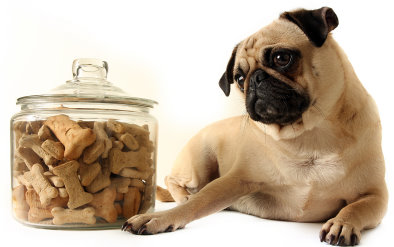|
Dog Training Tips: The 4 Great Principles
These Dog Training Tips Will Put You On The Right Track. The problem with Pugs is that they’re very cute. Some owners delay learning the dog training basics because they enjoy their furry little friend no matter what they’re doing! These easy-to-learn dog training tips will be a big help.You’ll do yourself a huge favor by establishing a level of discipline in your Pug’s life as early as possible. Here are the four guiding principles in training any dog. 1. Be Consistent In Your Approach While this may seem obvious, it is often overlooked especially if you have more than one person in the household. You want to be consistent in what you will allow your dog to do and not do. If jumping up on the furniture is not allowed every member of the household should understand that and deal with a couch happy Pug in the same manner. This is actually very beneficial to the Pug. They like knowing what the rules are and they like consistency. Being allowed to do one thing one day and not another creates some stress which is never a good thing for dog or owner. 2. You Can Be Firm AND Gentle Positive training or reinforcement, in our opinion, is the only approach to consider. We also think it’s tailor-made for the Pug. After all, they love to eat! A well-timed treat to reinforce desired behavior works very well for this seemingly starving little pooch. Positive reinforcement builds the bond between owner and dog and is actually better for your little friend. If a Pug could talk they’d probably tell you they support positive reinforcement. The old school of swatting the dog with a newspaper creates an aggressive, stressful environment. So does yelling. Keep in mind that positive reinforcement does not mean permissiveness. As part of your dog training tips remember that the overall goal is to set up limitations for what behavior is not appropriate or acceptable. 3. Reward Good Behavior The key to managing behavior lies in two principles. First, visualize the behavior that you actually want in place of the behavior you want to avoid. Second, reward you Pug’s behavior when he adopts the preferred activity. If your Pug is chewing on the furniture, give him a toy that you want him to chew on and reward him when he does that. Ideally, limit his opportunities to misbehave. If a room should be off limits put a gate up or be around to supervise where your Pug goes. Let’s be fair. A Pug’s natural inclination is to chew and to be curious. Channel that behavior. Limit his access to places you don’t want him to go and provide him with outlets for alternative behavior (like a toy to chew on). Finding ways to substitute alternative behavior is one of the most useful dog training tips there is. 4. Exercise! Exercise! Exercise! Perhaps most important in your dog training basics is to give you Pug the chance to exercise. They love a good brisk walk and, as we said before, this won’t do any harm to the owner either. If taking your Pug for a walk is not possible make sure they get adequate exercise opportunities. Always check with your vet to make sure Pug can handle an exercise regime and be cautious in hot weather. They will have trouble breathing with their flat nostrils. Don’t be surprised if they seem to have a little less energy in the heat – they do! The proper amount of exercise is good for behavior as well because a tired Pug is also a less mischievous Pug! It’s another of the dog training tips that will help you have a well behaved dog. The principles of Positive Dog Training are based on the disipline of behavioral psychology that was built on the work of Ivan Pavlov and B.F. Skinner. It is a fascinating area of learning and the rewards of becoming a skilled trainer for your Pug are many. It can be immensely enjoyable for both your Pug and you. You can easily master the basics of training your dog. Although Pug training may be a little more involved, all of the basic dog training principles apply. The myth that Pugs may be a little more difficult to housetrain because they can be a little stubborn is not really true in our experience. One of the best dog training tips we got in house training was to use a dog crate. There is a lot of training information out there and you can go crazy reading it all. We have found that there are three fundamental ingredients to any successful training program. Although we're talking about basic training, those three ingredients apply to any training. And it applies to dog with significant behavior problems as well. Changing a dog's behavior can be a little more complicated. For more information check out: Changing Behavior - Dog Training Tips Beyond Basic Training Dog training does not come naturally. Pug Behavior Problems such as excessive barking or agression when facing strangers can represent a challenge and require certain techniques that can be mastered. We know of one program that has a phenomenal success rate when it comes to Dog Training. The testimonials speak for themselves. Many books have been written on dog training and there are many websites devoted to the subject. One of the better sites that we've come across takes a very unique approach to the subject by actually dealing with how dogs learn. They contend that "Mindful Leadership" brings out the Best in your dog. Everyone can do it! Every dog responds to it! You can find all of this and more at Voice 4 Dogs.
|

